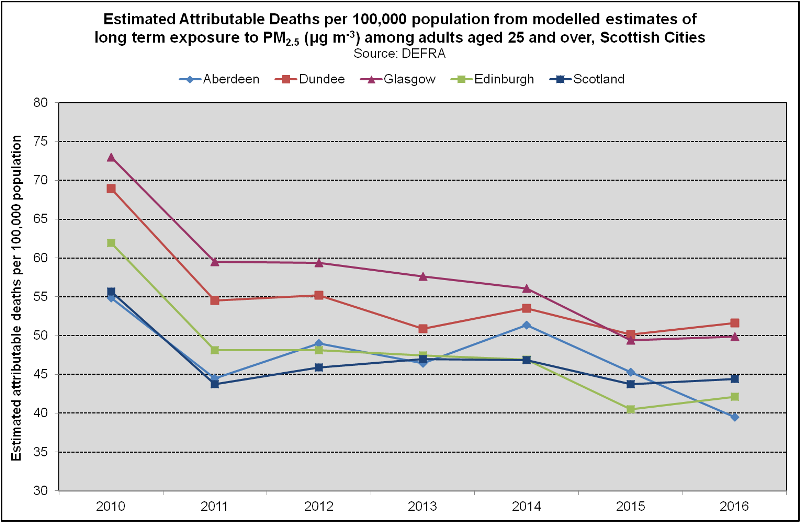Scottish cities
Small particulate matter
Small particulate matter (PM2.5 – atmospheric particulate matter with a diameter of less than 2.5 micrometers) is made up of fine particles that can be carried deep into the lungs where they can cause inflammation and a worsening of the condition of people with heart and lung diseases. They may also carry harmful compounds, absorbed on their surfaces, into the lungs. Current evidence suggests that there is no safe level of particulate matter in terms of human health effects.
This page provides modelled estimates of mean concentrations of PM2.5 and mortality attributable to PM2.5 in four Scottish cities.
Estimated mean concentrations of manmade (anthropogenic) PM2.5 in selected Scottish cities
 Overall, the mean concentration of PM2.5 has decreased between 2010 and 2019. Edinburgh had the highest mean concentration of PM2.5 for the majority of the period. Glasgow typically had the second highest mean concentration. All four major Scottish cities had higher mean concentrations than Scotland as a whole for most years. Glasgow's average concentration was 8.3 μg/m3 in 2010; by 2019, this had declined to 5.9 μg/m3.
Overall, the mean concentration of PM2.5 has decreased between 2010 and 2019. Edinburgh had the highest mean concentration of PM2.5 for the majority of the period. Glasgow typically had the second highest mean concentration. All four major Scottish cities had higher mean concentrations than Scotland as a whole for most years. Glasgow's average concentration was 8.3 μg/m3 in 2010; by 2019, this had declined to 5.9 μg/m3.
Particulate matter (PM2.5) estimated attributable deaths in selected Scottish cities
The evidence for the adverse effects of air pollution is strongest in relation to the impact of particulate matter, especially fine particulate matter (PM2.5). Exposure to PM2.5 is associated with an increased overall risk of death and shorter average life expectancy, especially for people who already have poor heart or lung health. Increasing evidence suggests that particulate matter, even at relatively low levels, may increase the risk of a range of other illnesses.
 Glasgow had the highest rate of estimated attributable deaths until 2015, when it was overtaken by Dundee. Generally, all four cities had higher rates of estimated attributable deaths than Scotland as a whole, until 2016. Overall, the number of estimated attributable deaths has declined over the time period, particularly in Glasgow, Edinburgh and Dundee. In 2010, Glasgow had approximately 73 deaths per 100,000 adults (aged 25 and over) attributable to PM2.5; by 2016 this had declined to approximately 50 deaths per 100,000 adults.
Glasgow had the highest rate of estimated attributable deaths until 2015, when it was overtaken by Dundee. Generally, all four cities had higher rates of estimated attributable deaths than Scotland as a whole, until 2016. Overall, the number of estimated attributable deaths has declined over the time period, particularly in Glasgow, Edinburgh and Dundee. In 2010, Glasgow had approximately 73 deaths per 100,000 adults (aged 25 and over) attributable to PM2.5; by 2016 this had declined to approximately 50 deaths per 100,000 adults.
PM10
PM10 denotes particulate matter 10 micrometers or less in diameter.
Current evidence suggests that there is no safe level of particulate matter in terms of human health effects. PM10 is among the most harmful of all air pollutants. When inhaled, these particles evade the respiratory system's natural defences and lodge deep in the lungs. Health problems begin as the body reacts to these foreign particles. PM10 can increase the number and severity of asthma attacks, cause or aggravate bronchitis and other lung diseases, and reduce the body's ability to fight infections.
Particulate matter (PM10) levels at monitoring sites in selected Scottish cities
 The graph shows that no monitoring sites breached the PM10 annual mean Air Quality Strategy (AQS) objective of 18μg/m3 in 2022.
The graph shows that no monitoring sites breached the PM10 annual mean Air Quality Strategy (AQS) objective of 18μg/m3 in 2022.
NO2
The main effect of breathing in raised levels of NO2 (nitrogen dioxide) is the increased likelihood of respiratory problems. Nitrogen dioxide inflames the lining of the lungs, and it can reduce immunity to lung infections. This can cause problems such as wheezing, coughing, colds, flu and bronchitis.
Nitrogen dioxide levels at monitoring sites in selected Scottish cities, 2022
 No monitoring site in Scotland's four largest cities breached the NO2 annual mean Air Quality Strategy (AQS) objective of 40 μg/m3 in 2022. The highest level recorded was at Glasgow (Kerbside) on Hope Street (39.1 μg/m3), a site which has in the past regularly breached AQS annual mean objective since recording started in the late 1990s, as shown in the Glasgow trends section.
No monitoring site in Scotland's four largest cities breached the NO2 annual mean Air Quality Strategy (AQS) objective of 40 μg/m3 in 2022. The highest level recorded was at Glasgow (Kerbside) on Hope Street (39.1 μg/m3), a site which has in the past regularly breached AQS annual mean objective since recording started in the late 1990s, as shown in the Glasgow trends section.
Notes
1. These data are derived from the Air Pollution & Health Briefing Note (Mortality associated with exposure to fine particulate matter (PM2.5 attributable mortality) in Scotland) published by Health Protection Scotland in June 2018.
2. In 2016 Scotland opted to make its annual mean PM2.5 objective more stringent,by reducing it from 12 µg m-3 to 10 µg m-3 in line with the World Health Organization guideline.
3. Only monitoring stations classified as kerbside, roadside, urban centre and urban background are included.
4. The Air Quality in Scotland site provides up-to-date estimates of air quality from monitoring sites across Scotland.
5. The Scottish Government's air quality policy: Cleaner Air for Scotland 2 - Towards a Better Place for Everyone
